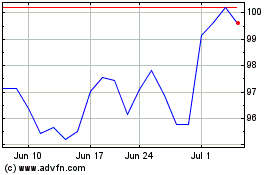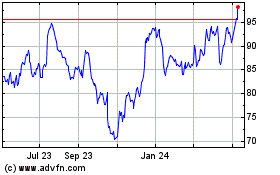Bank of America, Morgan Stanley to Invest in Luma Financial -- Update
July 31 2018 - 11:17AM
Dow Jones News
By Liz Hoffman
Goldman Sachs Group Inc. has Simon, an online platform that
sells complex investment products to mom-and-pop investors. Bank of
America Corp. and Morgan Stanley are now throwing their weight
behind Luma.
The two firms plan to announce Tuesday that they are backing a
new company, Luma Financial Technologies, to connect retail brokers
seeking market-linked CDs, structured notes and other products to
the banks that issue them.
Bank of America and Morgan Stanley will invest in Luma and will
sell their own products to its clients. Luma's software and its
chief executive, Tim Bonacci, come from Navian Capital, a
wholesaler of structured products since 2011.
Mr. Bonacci declined to comment on the financial terms, as did a
spokesman for Morgan Stanley. A representative for Bank of America
couldn't be immediately reached for comment.
Structured notes are custom-built by banks out of options and
other derivatives. Investors pay an upfront sum -- helping banks to
fund their operations -- and receive a future payout that is based
on the performance of another asset, such as the S&P 500 index
or oil prices.
The new venture will compete directly with Goldman's platform,
which launched in 2015 and sells notes through broker networks such
as Raymond James Financial Inc. and LPL Financial Holdings Inc. The
goal of Luma, Simon and a handful of startups is to replace
expensive human sales forces and lay cheaper, digital pipes to the
retail investors who buy structured notes.
Mr. Bonacci compared these digital middlemen to clearing firms
and stock exchanges, with the field winnowing over time.
"I don't think there will be 10. I don't think there will be
one," Mr. Bonacci said in an interview. "We're one of those leaders
today and I think the opportunity to grow the market and our share
in it are significant."
Structured products have exploded in complexity and variety over
the past few years after taking a beating during the financial
crisis. Regulators have cracked down, in some cases alleging that
investments are being sold to clients who don't understand the
risks.
Bank of America's Merrill Lynch unit in 2016 paid $10 million to
the Securities and Exchange Commission to settle allegations that
it misled investors on notes that later plummeted in value. UBS
Group AG in 2015 paid $19.5 million in a similar case.
Bank of America and Morgan Stanley both sell structured notes,
largely into their own wealth-management arms. Backing Luma could
give them broader access to third-party distributors -- if the new
venture can ink deals with larger networks and win the loyalty of
retail brokers.
Navian has historically sold to smaller distributors including
Capital One Financial Corp. and MUFG Union Bank NA in
California.
The Wall Street Journal reported last year that Goldman was
looking to spin off Simon. It is talking to investors including
JPMorgan Chase & Co. and Barclays PLC, two of the biggest
issuers of structured notes in 2017, according to people familiar
with the matter.
Write to Liz Hoffman at liz.hoffman@wsj.com
(END) Dow Jones Newswires
July 31, 2018 11:02 ET (15:02 GMT)
Copyright (c) 2018 Dow Jones & Company, Inc.
Morgan Stanley (NYSE:MS)
Historical Stock Chart
From Mar 2024 to Apr 2024

Morgan Stanley (NYSE:MS)
Historical Stock Chart
From Apr 2023 to Apr 2024
